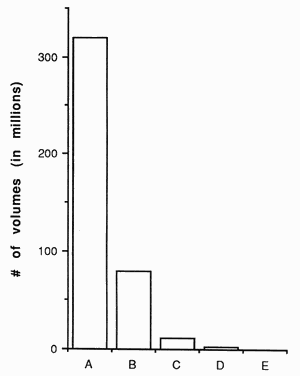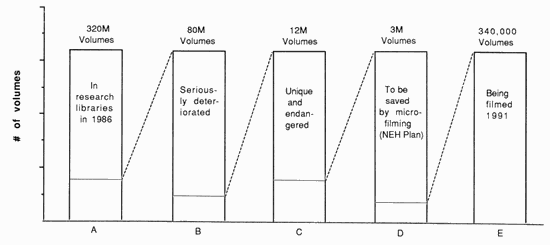

The figures an the two graphs below were taken from "The 20-Year Brittle Books Program" (Commission on Preservation and Access Newsletter, June 1991), where they are presented graphically but in different form, with a projection to the year 2010. That year will mark the end of funding provided by Congress to the National Endowment for the Humanities for grants to help libraries microfilm brittle books.
Two graphs are shown here in order to get a perspective on this huge task. The largest figure (320 million) is almost 100 times as large as the smallest (340,000). Any bar graph that was big enough to make smallest figure visible, say with a bar only 1/8" high, would have had to be printed on a sheet of paper 14" long. The point is to show the immensity of the problem of deteriorated books, some of the ways in which the problem had to be cut down to size so that achievable goals could be set, and the relatively small amount accomplished to date (if one can call filming 340,000 books a small accomplishment).
In the bar graphs, the tallest bar (A) is not the one that shows the size of the problem. Neither is Bar B, because many of these 80 million volumes are duplicates or will be discarded and replaced for a variety of reasons. Bar C comes closest to representing the heart of the brittle (and deteriorated) book problem. Not all those 12 million books need to be microfilmed, though; many of them could not be satisfactorily filmed anyhow, because of color illustrations or other considerations. Some are deteriorated only because they need binding. An estimated 25% can be, or will need to be, retained in their original format, by binding, boxing, conservation or other means.
By 2010, according to CPA estimates, the number of volumes in research libraries will have grown by 2/3 to about 530 million. Since the proportion that are brittle is predicted to stay about the same- (23% of the total, possibly less), the number of brittle books that need filming will also have grown, and we will be ready for another round of funding and filming by 2010. Fortunately, alkaline paper is now used in most hard cover and many soft-cover books in this country, so at least we are not continuing to make the problem worse.
One should bear in mid that these figures and graphs are only
estimates and they cover only research libraries. They do not cover
archives, public libraries, personal libraries and files, corporate
files and libraries, research records and so on.

